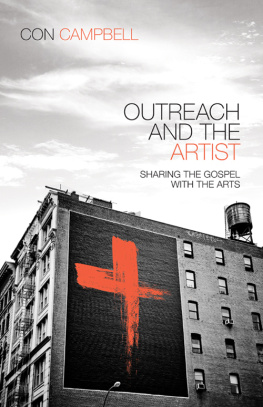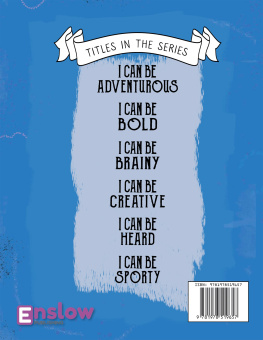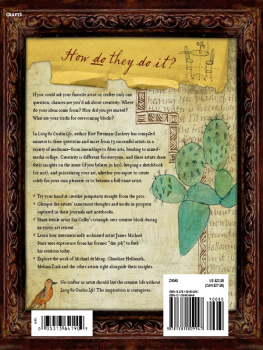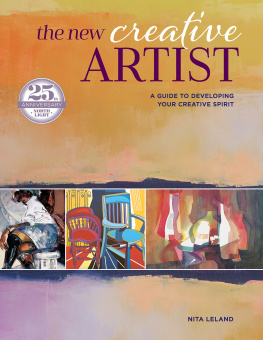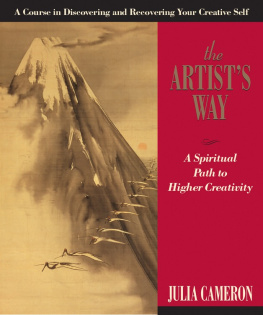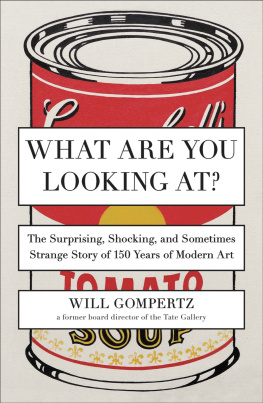In Order of Appearance
Ninette de Valois
Frederick Ashton
Andy Warhol
Vincent van Gogh
Theaster Gates
Bridget Riley
Roy Lichtenstein
David Ogilvy
Marina Abramovi
Gilbert & George
Caravaggio
Picasso
J. J. Abrams
Piero della Francesca
Luc Tuymans
Johannes Vermeer
Peter Doig
Rembrandt
Kerry James Marshall
Michelangelo
Ai Weiwei
David Hockney
Marcel Duchamp
Bob and Roberta Smith

By the same author
What Are You Looking At?
Editor: Michael Sand
Designer: Darilyn Lowe Carnes
Production Manager: Anet Sirna-Bruder
Library of Congress Control Number: 2015957311
ISBN: 978-1-4197-2183-0
eISBN: 978-1-6131-2956-2
Copyright 2015 Will Gompertz
First published in the United Kingdom by Penguin Books Ltd.
Published in 2016 by Abrams Image, an imprint of ABRAMS. All rights reserved. No portion of this book may be reproduced, stored in a retrieval system, or transmitted in any form or by any means, mechanical, electronic, photocopying, recording, or otherwise, without written permission from the publisher.
Abrams Image books are available at special discounts when purchased in quantity for premiums and promotions as well as fundraising or educational use. Special editions can also be created to specification. For details, contact specialsales@abramsbooks.com or the address below.

115 West 18th Street
New York, NY 10011
www.abramsbooks.com
In memoriam
Steve Hare
Contents
Andy Warhol, Vincent van Gogh, Theaster Gates
Bridget Riley, Roy Lichtenstein, David Ogilvy
Marina Abramovi, Gilbert & George, Caravaggio
Picasso
J. J. Abrams, Piero della Francesca
Luc Tuymans, Johannes Vermeer
Peter Doig, Rembrandt, Kerry James Marshall
Michelangelo, Ai Weiwei
David Hockney, Marcel Duchamp
Bob and Roberta Smith
PREFACE
We cannot all paint like Picasso or sculpt like Michelangelo, but we can all think like an artist.
When Marcel Duchamp asked, Why does art have to be beautiful? in 1917, he changed art forever. You or I could have done that. And we could have sparked an entire art movement like Damien Hirst did in 1991 by convincing an art dealer to pay to put a dead shark in a tank of formaldehyde.
Even the mighty Czanne is within our reach. He realized in the late nineteenth century that a subject shown from two different viewpoints in the same painting appeared more urgent and honest. Why? Because thats how we see: with two eyes, not one. It was the insight that led to modernism in all its forms. We could have figured that out.
So, why dont we come up with great ideas if theyre so easy? Well, we can. And my hope is that this book will help show you how.
INTRODUCTION
Creativity is a hot topic. It is a subject thats exciting politicians, academics and wise men and women the world over. They say it is very important. That it will be central to our future prosperity. Which is all well and good. But what exactly is creativity and how does it work?
And why do some people appear to find it easy to come up with brilliant, fresh ideas while others dont? Is it simply a case of creative types being programmed differently, or does it have more to do with behavior and attitude?

A
WE ARE ALL ARTISTS.
We are a uniquely imaginative species. Our ability to conceive complex ideas and realize them requires a series of cognitive processes that are beyond the capability of any other life form or any machine. For us, its no big deal. We do it all the time, from preparing a meal to texting a witty message to a friend. We might consider them mundane tasks but they still require us to imagine, to be creative. Its a fantastic natural gift which, when cultivated properly, can enable us to achieve the most extraordinary things.
Using our imagination enlivens and enriches our minds and our life experience. We come into our own when we exercise our brains, when we think. I have never met an artist of any type who is indifferent or incurious. The same goes for successful chefs, gardeners and sports coaches; anybody in fact who has a zest for their subject and a willingness to innovate. They have a brightness in their eyes that radiates a palpable life force. Being creative has that effect.
So how do we go about harnessing this innate talent? How can we take our creativity off autopilot to generate those bold original concepts that could add value to our lives and maybe even to the wider world? And, more specifically, how do we trigger our imagination to conjure up the innovative thoughts that could be turned into something material and worthwhile?
Ive been thinking about these questions for the best part of three decades. At first it was because new ideas and talented people fascinated me. And then it became part of my job as a publisher, producer, writer, broadcaster and journalist working in the arts.
Ive had the privilege of being able to observe and meet some of the greatest exponents of creative thinking today, from the audacious British artist Damien Hirst to the multi-Oscar-winning American actress Meryl Streep. Obviously, they are all different, but in one regard, at least, not quite as different as you might imagine.
Over the years it has become pretty evident to me that there are a handful of clearly identifiable traits that are common to all successful creative people, from novelists and film directors to scientists and philosophers. Im not talking about fanciful otherworldly qualities, but the basic practices and processes that allow their talents to flourish. Practices and processes which, if adopted, could help the rest of us unleash our own latent creativity.
And creative talent is something we all have, of that there is no doubt. True, some people may be more adept at composing music than others, but that doesnt immediately render the non-composers uncreative. The fact is we are all perfectly capable of being artists of one type or another. Each and every one of us has the capacity to conceptualize, to step out of time and space and consider instead a range of abstract ideas and associations that are unrelated to each other or the present moment. We do it when we are daydreaming, or speculating, or even when we are telling lies.
The problem is, some of us have either convinced ourselves that we are not creative, or are yet to find our way. Confidence in our own creativity can wane. Which is bad. Confidence is crucial. In my experience artists, like a lot of us, fear being found out. But somehow they manage to summon up enough self-belief to overcome the self-doubt, which enables them to back their creativity. The Beatles were just a bunch of young lads with time on their hands who found the confidence to persuade themselves and then the world that they were musicians.
They didnt wait to be asked. Artists dont seek permission to paint or write or act or sing; they just do it. What tends to set them apart, and gives them their power and purpose, is not their creativity per sewe all have that. Rather, its the fact that they have found a focus for it, an area of interest that has fired their imagination and provided a vehicle for their talents.
Next page



